Santo Domingo
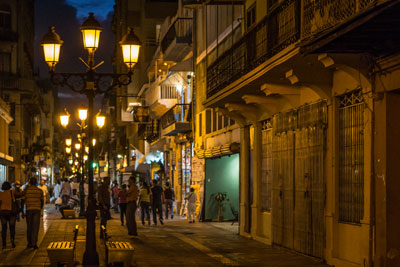 Situated at the mouth of the Ozama river, Santo Domingo, the capital of the Dominican Republic, is the oldest permanent city constructed by Europeans in America. Its cathedral is also the first to be built in the New World. Santo Domingo was founded in 1496 by Bartholomew Columbus, brother of Christopher Columbus and was called at its origin Nueva Isabela in honor of the Queen Isabela I of Spain. It is the largest metropolitan area in the Caribbean by population and the cultural, commercial, political and industrial center of the Dominican Republic. The city harbor at the mouth of Ozama River accommodates very large vessels and the San-Souci facility is a port of call for cruise ships.
Situated at the mouth of the Ozama river, Santo Domingo, the capital of the Dominican Republic, is the oldest permanent city constructed by Europeans in America. Its cathedral is also the first to be built in the New World. Santo Domingo was founded in 1496 by Bartholomew Columbus, brother of Christopher Columbus and was called at its origin Nueva Isabela in honor of the Queen Isabela I of Spain. It is the largest metropolitan area in the Caribbean by population and the cultural, commercial, political and industrial center of the Dominican Republic. The city harbor at the mouth of Ozama River accommodates very large vessels and the San-Souci facility is a port of call for cruise ships.
As Santo-Domingo became the oldest European city in the Americas, it was the gateway to the Caribbean and the town where all expeditions which led to colonization of Puerto Rico by Ponce de Leon, of Mexico by Hernan Cortez, of Cuba by Diego Velazquez de Cuellar were launched.
As Santo Domingo was captured in 1586 by Francis Drake and held for ransom, it was the signal of the decline of Spanish dominion over Hispaniola. In 1697 the Treaty of Ryswick acknowledged France occupancy of the western third of the Island. Santo Domingo was ceded to the French in 1795, briefly captured by Haitian Rebels in 1801, recovered by the French in 1802, reclaimed by Spain in 1809, occupied by the Criollo bourgeois with Nunez de Caceres in 1821, unified with Haiti two months later. Santo Domingo became the capital of the independent Dominican Republic in 1844 when the country, led by Juan Pablo Duarte, gained independence from Haiti. Under a bargain with Pedro Santana, Spain took over the country again in 1861. Supported by the Republic of Haiti, the Dominicans who were partisans of independence from Spain launched in 1863 the Dominican Restoration War against Spain and freed the country from its domination. Santo Domingo and the Dominican Republic were occupied by the US between 1916 and 1924.
Among the most important attractions of Santo Domingo as tourist destination, we can cite the Zona Colonial, a UNESCO World Heritage Site since 1990, the Fortaleza Ozama, the Cathedral Primada de America, The Alcazar de Colon, the Monasterio of San Francisco, Plaza Espana.
Want to order a tour to this city? Click here
Boca Chica – Juan Dolio
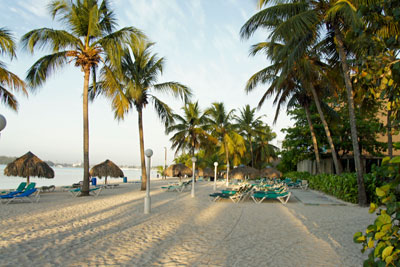 Boca Chica is a small touristic town, a municipality of Santo Domingo near the airport of Las Americas, well known for its long beach with white sand facing the mangrove-covered islet La Matica. The main street of Boca Chica called Calle Duarte is pedestrian-only in the evenings and is unique for its lively nightlife.
Boca Chica is a small touristic town, a municipality of Santo Domingo near the airport of Las Americas, well known for its long beach with white sand facing the mangrove-covered islet La Matica. The main street of Boca Chica called Calle Duarte is pedestrian-only in the evenings and is unique for its lively nightlife.
The development of Boca Chica, which was originally founded by Juan Baptista Vicini Burgos who established sugar plantations there, started in 1950 as Trujillo ordered the construction of Hotel Hamaca. This very important hotel which became an icon and hosted Fulgencio Baptista after the Cuban revolution, was closed after the Trujillo assassination, abandoned during more than 20 years and reopened in the early 1990s.
Boca Chica is the most crowded beach of the Dominican Republic because of its beauty, crystalline waters, white sands and its proximity to the capital Santo Domingo. Boca Chica has two marinas and lots of bars, restaurants, souvenirs shops, loud music, close to the beach shore.
Juan Dolio, located close to Boca-Chica, is a small seaside community and tourist destination in the municipality of Guayacanes, province of San Pedro de Macoris. During the late 1980s Juan Dolio became one of the first tourist resorts in the country and an exclusive destination for mainly European tourists. Later the business concept of an All-inclusive resort offered by the various hotels lead to a tourist boom and the construction of new hotels in the western part of Juan Dolio. In 1995 the hotels in Juan Dolio had a daily average of 5,500 tourists. After the passage of hurricane Georges, many of the investors moved to Punta Cana and some of the older hotels were demolished and became development sites for real estate projects.
Want to order a tour to this city? Click here
Punta Cana
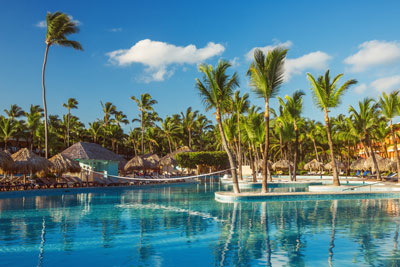 Punta Cana, a resort town of the Punta Cana-Bavaro-Veron-Macao district in the municipality of Higuey in the Province of Altagracia, is the easternmost tip of the Dominican Republic and is known for its 32 km stretch of beaches and clear waters. Punta Cana is among the best golf destination in the world and is popular for zip-lining, kayaking, sailing and windsurfing. The beaches are just perfect with calm and warm water and the magical lagoons of the indigenous Eyes Ecological Park are simply majestuous.
Punta Cana, a resort town of the Punta Cana-Bavaro-Veron-Macao district in the municipality of Higuey in the Province of Altagracia, is the easternmost tip of the Dominican Republic and is known for its 32 km stretch of beaches and clear waters. Punta Cana is among the best golf destination in the world and is popular for zip-lining, kayaking, sailing and windsurfing. The beaches are just perfect with calm and warm water and the magical lagoons of the indigenous Eyes Ecological Park are simply majestuous.
Punta Cana is a very popular tourist destination and plays a key role as contributor to the tourism industry in the Dominican Republic with many resorts, hotels, restaurants. From there, tourist can go nautical (surfing, boat riding, scuba diving, deep sea fishing, etc), ecological (safari tours, horseback riding, dune buggy). Excursions will bring you to La Saona and La Catalina Island, to Santo-Domingo, to Los Haitises National Park, to Samana, to the Basilic Catholic Monument of Higuey,
Most of the resorts in Punta Cana are family-friendly with small entertainment facilities for children and all-inclusive activities. Many dream weddings are also held there. With flights from 26 countries, the Punta Cana International Airport stands as the best-connected in the Caribbean and Central America. The new highway between Santo-Domingo and Punta Cana allows tourists to easily connect with La Romana, Boca Chica and the Capital.
Want to order a tour to this city? Click here
Puerto Plata – Sosua – Cabarete
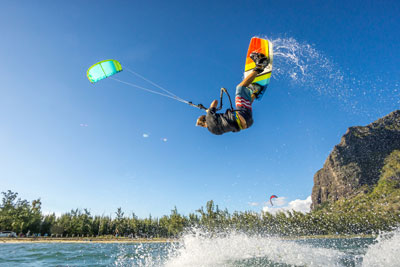 San Felipe de Puerto Plata, the capital of the Puerto Plata province, is the ninth-largest city in the Dominican Republic. The city is best known for its beaches and has resorts such as Playa Dorada and Costa Dorada. It has an aerial tramway in which visitors can ride to the Pico Isabel de Torres, a 793 meter high mountain.
San Felipe de Puerto Plata, the capital of the Puerto Plata province, is the ninth-largest city in the Dominican Republic. The city is best known for its beaches and has resorts such as Playa Dorada and Costa Dorada. It has an aerial tramway in which visitors can ride to the Pico Isabel de Torres, a 793 meter high mountain.
Situated about 15 kilometers east of the city of Puerto Plata, the Gregorio Luperon International Airport serves the whole region of Puerto Plata, Sosua, Cabarete y Rio San Juan. Close to the City, the Cruise Line Carnival opened in 2015 an $85-millon cruise port called Amber Cove. Among the best attractions in Puerto Plata, we can mention:
- The Fort of San Felipe
- Ocean World
- Teleferico
- Beaches (La Poza del Castillo, Cofresí, Costámbar, Long Beach, Marapicá, Playa Dorada, Maimón, Bergantín, among others)
Sosúa is a resort town in Puerto Plata Province, located east, at 20-minute drive from the City of Puerto Plata. It is especially known for Sosúa Beach, and is divided into 3 sections: El Batey, Los Charramicos and Sosua Abajo. Between 1940 and 1945, about 800 German and Austrian Jewish refugees received asylum from the Dominican Government and settled in Sosua. They built a dairy and cheese factory which is still in function. The descendants are still living in Sosua and they maintain a synagogue and a museum. The towm of Sosua was barely known until the tourism sector took off in the country in the mid-1980s.
10 minutes away from Sosua, driving east, is the resort town named Cabarete which possesses a famous 3-km beach protected by a coral reef. It is a great center for water sports, due to the breezy conditions on the beach. It is the greatest reference for kite-surfing in the country. Cabarete beach is one of the best in the country with its calm environment, its nightlife and its many restaurants.
Cabarete was founded in 1835 by Zephaniah Kingsley along with his mixed-race family, and 53 slaves he freed from his Florida plantations and brought here while the island was under Haitian administration. Anna Kingsley owned a house in the harbor that stretched out to the sea. Several descendants of the Kingsleys and of the former slaves live in the area today.
Want to order a tour to this city? Click here
Samana
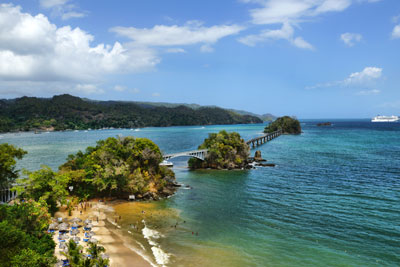 Santa Bárbara de Samaná is a natural treasure, a town on the Samaná Peninsula. Wild, verdant, with coves, bays, waterfalls, mountains and awe-inspiring views, there is a lot to explore. It overlooks Samaná Bay, which plays host to thousands of humpback whales during winter’s mating season. The town’s Malecon has restaurants and bars. In the bay, Cayo Levantado is a tiny island known for its palm-lined beaches. Cruise ships arrive mainly in the winter season docking offshore near Cayo Levantado.
Santa Bárbara de Samaná is a natural treasure, a town on the Samaná Peninsula. Wild, verdant, with coves, bays, waterfalls, mountains and awe-inspiring views, there is a lot to explore. It overlooks Samaná Bay, which plays host to thousands of humpback whales during winter’s mating season. The town’s Malecon has restaurants and bars. In the bay, Cayo Levantado is a tiny island known for its palm-lined beaches. Cruise ships arrive mainly in the winter season docking offshore near Cayo Levantado.
Samana was discovered by Christopher Columbus on January 12, 1493 as he was welcomed with a shower of spears and arrows from the native Taino warriors. It was probably the first violent opposition to the Spanish conquistadors in the Americas. Samana is also home of many black Americans who immigrated starting 1824, taking advantage of the pro-African immigration policy of the Haitian Government led by Jean-Pierre Boyer as the country was under Haitian rule. This migration in Samana began with 34 African-American families. Up to now, they still maintain many elements of their culture such as their games, community organizations, their names, manners, music, food and some special recipes.
There is nowadays a special 120-km highway, opened to the public in 2008, which connects the east of Santo Domingo to the Peninsula of Samana. This infrastructure facilitated the tourism development of the peninsula.
Want to order a tour to this city? Click here


